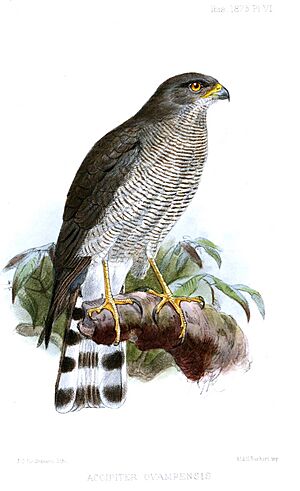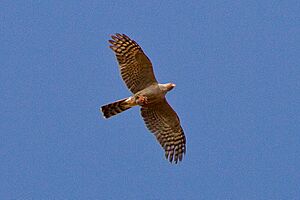Ovambo sparrowhawk facts for kids
Quick facts for kids Ovambo sparrowhawk |
|
|---|---|
 |
|
| Conservation status | |
| Scientific classification | |
| Synonyms | |
|
The Ovambo sparrowhawk (also called Ovampo sparrowhawk) is a cool bird of prey found in Africa south of the Sahara Desert. Its scientific name is Accipiter ovampensis. This bird gets its name from a place called Ovamboland in northern Namibia. It belongs to the Accipitridae family, which includes many types of hawks and eagles.
Contents
What Does the Ovambo Sparrowhawk Look Like?
The Ovambo sparrowhawk is a small sparrowhawk. It has wide wings and a long tail, which is typical for birds in the Accipiter group. Adult birds have plain grey feathers on their upper body. They have white stripes on their lower back and white feathers underneath. These white feathers often have thin grey stripes, but the area under the tail is plain white.
The tail has three dark stripes and a wide, dark band near the end. The bird's beak is black, and its eyes are a deep red color. The skin around its beak (called a cere) is red, and its legs are orange.
Some Ovambo sparrowhawks are completely black. These are called melanistic forms. Even these black birds have white stripes on the flight feathers under their wings. Young Ovambo sparrowhawks are usually browner. They might have white feathers on their belly and head, or a brown head with reddish-brown feathers underneath.
Female Ovambo sparrowhawks are bigger than males. Females weigh about 180 to 305 grams, while males weigh 105 to 190 grams. These birds are about 30 centimeters (12 inches) long. Their wingspan, which is the distance from wingtip to wingtip, is about 67 centimeters (26 inches).
Where Do Ovambo Sparrowhawks Live?
Ovambo sparrowhawks live across Africa south of the Sahara Desert. They mostly breed in areas south of the equator. You can find them in eastern Africa, from Ethiopia and Eritrea down to Tanzania. However, they are not very common there.
Their main home is in southern Africa. This area stretches from the southern Democratic Republic of Congo to northern Namibia, Botswana, northern South Africa, Eswatini, and Mozambique. In western Africa, they live from the Central African Republic in the east to the Ivory Coast in the west. Birds seen in the northern parts of Africa might be visitors who don't breed there.
What Kind of Places Do They Like?
Ovambo sparrowhawks usually prefer to live near the edges of dry forests and woodlands. They also like areas with planted trees, like eucalyptus farms. They often move into nearby savannas and tall woodlands that have open spaces. This includes areas along rivers or woodlands with broad-leaved trees.
In southern Africa, their favorite places often have specific types of trees. These include miombo trees (Brachystegia spp), Mahobohobo trees (Uapaca kirkiana), or Zambezi teak trees (Baikiaea plurijuga).
How Do Ovambo Sparrowhawks Hunt?
The Ovambo sparrowhawk mainly hunts other birds. They usually catch birds that weigh up to 60 grams. However, larger female sparrowhawks can catch bigger birds, like doves, which can weigh up to 250 grams. There's even a record of one catching a budgerigar!
These sparrowhawks hunt a bit like falcons. They fly high in the sky and then dive down very fast onto their prey. After diving, they might chase the prey for 100 to 200 meters (330 to 660 feet). But when they are not hunting, they often sit quietly hidden within the trees.
Life Cycle and Reproduction
Ovambo sparrowhawks are very protective of their territory. The female bird does most of the work building the nest. She makes a platform out of sticks and lines it with pieces of bark and sometimes fresh green leaves. The nest is usually placed high up in a tree. This can be a native tree or a tree that was planted, like a eucalyptus.
The female lays her eggs between August and November, with most eggs laid in August and September. A female can lay between one and five eggs. She sits on the eggs to keep them warm (this is called incubating). While she is incubating, the male bird brings her food, usually two or three times a day.
After the chicks hatch, the male continues to bring food for both the female and the young birds for about 18 days. After that, the female also starts to hunt for food. The young birds are ready to fly (fledge) when they are 33 to 39 days old. They become fully independent about one month after they start flying.
Taxonomy
Scientists believe the Ovambo sparrowhawk is closely related to the Madagascar sparrowhawk (Accipiter madagascarensis). Studies of their genes show that these two species are part of the same group.



